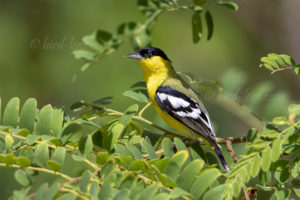 Marshall’s Iora (Aegithina nigrolutea) – recently called White-tailed Iora – is endemic to the Indian Subcontinent, where it prefers lowland thorn scrub and tree groves. It is closely related to the Common Iora (Aegithina tiphia) and the two were previously considered conspecific. In Sri Lanka I had the opportunity to observe a male neaer the Weheragala Reservoir in the Yala National Park that only needs to be agitated slightly. Then the bird stands on the dry branches of a bare tree. After a short time it changes to a bush with lush green leaves. A little later, the bird decides again for the lower, more stable branches of the bare tree. After a while, the bird begins to take the rival male seriously. The wings are stretched and the beautiful white stripes come into their own. Then it comes down so far that I can photograph the male at eye level in a tree that looks like a black locust. From time to time the white-tailed iora sings. Finally, the male of the White-tailed Iora begins to search leaves and branches for food at a short distance; possibly as a skipping act. The whole performance has now lasted more than half an hour. Very remarkable. This is the only place far and wide to reliably see the Marshall’s Iora / White-tailed Iora in Sri Lanka, as my guide emphazises.
Marshall’s Iora (Aegithina nigrolutea) – recently called White-tailed Iora – is endemic to the Indian Subcontinent, where it prefers lowland thorn scrub and tree groves. It is closely related to the Common Iora (Aegithina tiphia) and the two were previously considered conspecific. In Sri Lanka I had the opportunity to observe a male neaer the Weheragala Reservoir in the Yala National Park that only needs to be agitated slightly. Then the bird stands on the dry branches of a bare tree. After a short time it changes to a bush with lush green leaves. A little later, the bird decides again for the lower, more stable branches of the bare tree. After a while, the bird begins to take the rival male seriously. The wings are stretched and the beautiful white stripes come into their own. Then it comes down so far that I can photograph the male at eye level in a tree that looks like a black locust. From time to time the white-tailed iora sings. Finally, the male of the White-tailed Iora begins to search leaves and branches for food at a short distance; possibly as a skipping act. The whole performance has now lasted more than half an hour. Very remarkable. This is the only place far and wide to reliably see the Marshall’s Iora / White-tailed Iora in Sri Lanka, as my guide emphazises.
Marshall’s Iora is not a well-studied species, and it is suspected to be under pressure owing to destruction of its habitat, especially due to cutting down of scrub forests. Although it is treated in literature as monotypic, further taxonomic research is required for populations resident in South India and Sri Lanka.
The bird ist endemic to the Indian Subcontinent. The distribution of the Marshall’s Iora or White-tailed Iora is patchily in India and Sri Lanka. In Sri Lanka, it occupies the dry lowlands from east to south and the place to see is probably the Lunugamvehera National Park, a part of the Yala National Park complex.
It is a question of whether the current distribution of the species is actually incoherent, or whether there are two or more populations. Its occurrence in Sri Lanka was previously unknown and it was only recently added to the country’s list of avifauna. This species is not too difficult to observe as it is often detected by its wide variety of songs and calls, which are used frequently while feeding. It has a spectacular courtship display, in which the male flies up in the air with fluffed up plumage and ‘parachutes’ or glides down spirally exposing its whitish rump feathers. It looks like a ball of fluff.
For the future, the population of Marshall’s Iora in Sri Lanka must be investigated further, as morphological and vocal differences to the populations in India have already emerged. The Marshall’s Iora should therefore be scientifically examined morphologically and vocal in detail. Samples should also be taken from these regions for DNA analysis to determine whether there are consistent differences for the three populations detected. So there is a possibility that there will be a taxonomic revision of the Marshall’s Iora in the future.
In order to meet the growing demand for top images of the rarer species of Palaearctic Bird-lens.com has specifically made trips to remote places. Additionally every chance is used, if a rare bird is around the homeground. This to do everything to ensure excellent photos of the Birds of the Western Palearctic . The yield of pictures also of rare Western Palaearctic birds is very good. There are other nice images of birds, that you will find behind the tab “Picture Shop“. Just give a notice if you need a picture of a bird which is not online